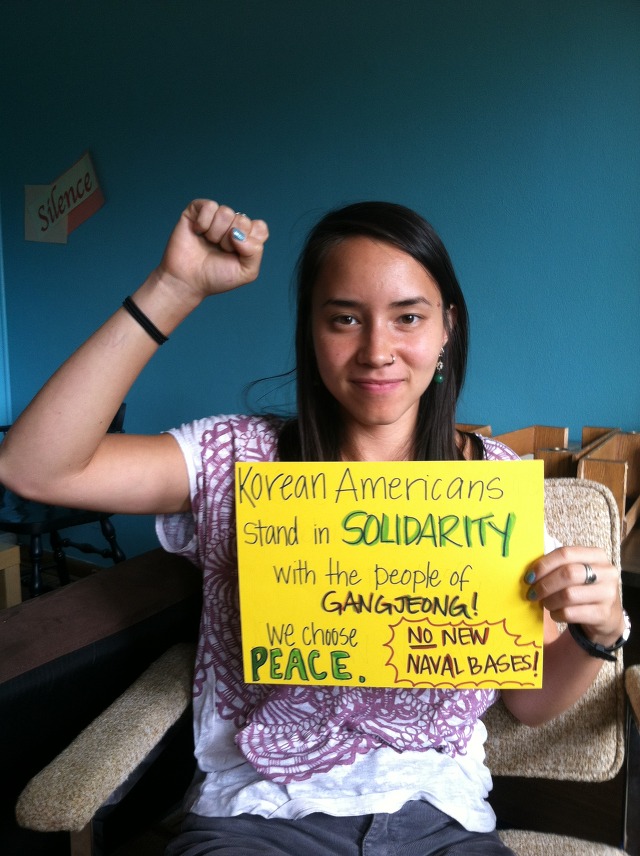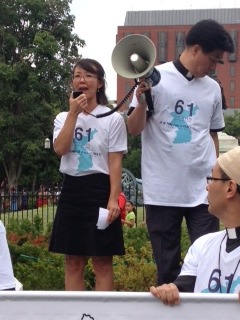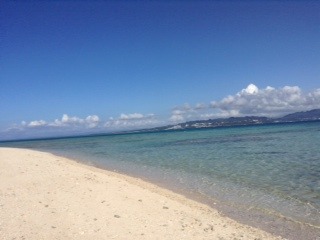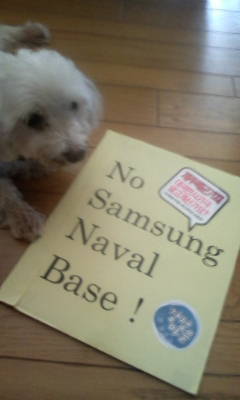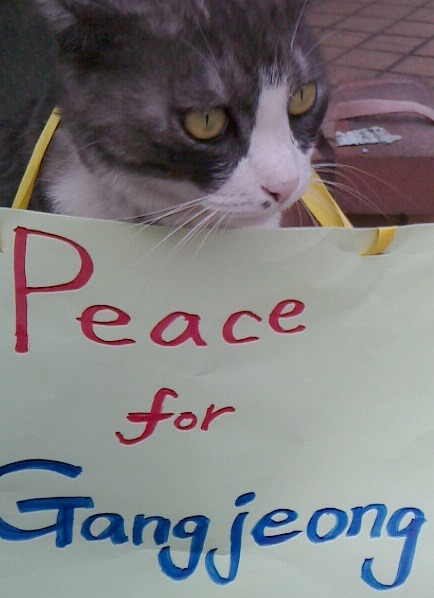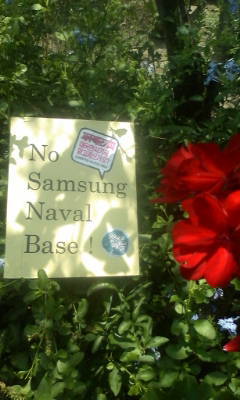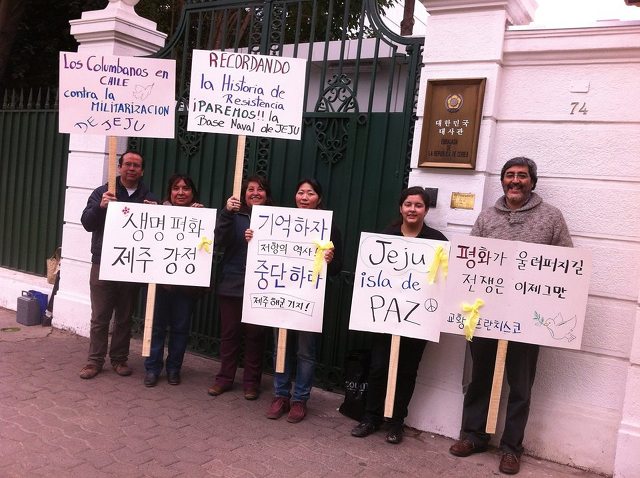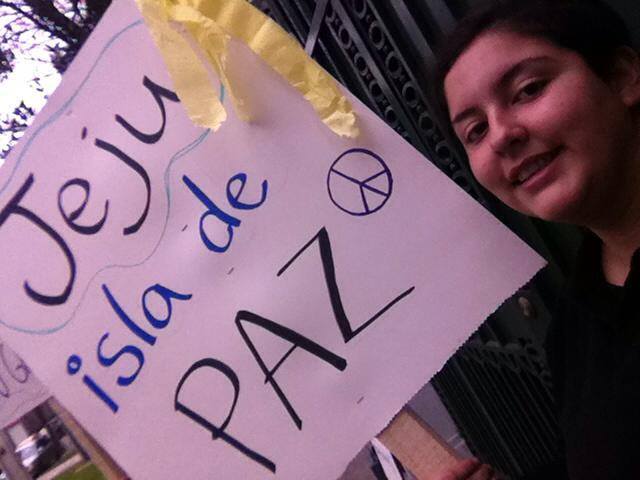In this March Edition:
Gureombi Remembrance Day, Permanent War, “Gureombi, The Wind is Blowing” travels the world, Women Crossing the DMZ Borders, Protecting Democracy or an Occupying Army? Choosing Arrest Rather than Paying Fines, Human Rights: Forever a Fugitive, Crosscurrents, Interview with Gangjeong Women’s Association leader Jeong Young-sim, Welcoming Grandma Youngdeung, Visit to the US Congress for Jeju 4·3 Solution, Remembering Fukushima and much more!
Save Jeju Now
No War Base on the Island of Peace
Tag: international solidarity
-
Connecting the dots between Bangor and Jeju
Re-blogged from here
See also the video by Rodney Herold, ‘ Second Day Walk- Steilacoom to Tacoma‘
……………………………………..
Ground Zero holds mock funeral for the Earth at at Bangor Trident base
By Leonard Eiger
Over sixty people participated in Ground Zero Center for Nonviolent Action’s annual celebration of Martin Luther King Jr’s life and legacy on Saturday, January 17, 2015. The event concluded with a vigil and nonviolent direct action at Naval Base Kitsap-Bangor in Silverdale, Washington.Under the theme “Building the World House,” the day focused on Dr. King’s commitment to nonviolence and his opposition to war and nuclear weapons. Dr. King’s essay “The World House” may very well be the best summation of Dr. King’s teachings.
While some participants maintained a peaceful vigil at the Main Gate to Naval Base Kitsap-Bangor in Silverdale, Washington on Saturday afternoon, others dressed in black monk’s robes carried a coffin containing a globe representing the earth to the side of the road. People walked up to the casket and placed flowers on it, and then another robed participant recited a eulogy, “Mourning the Death of the Earth after Nuclear Annihilation.” A funeral dirge completed the ceremony.
When the ceremony was finished participants carried the casket onto the roadway, blocking traffic entering the base. Washington State Patrol officers ordered the resisters to move the coffin out of the roadway. They complied, and carried the coffin to the median where they were detained. All received citations for being in the roadway illegally, and then released.
Those cited were Mary Elder, Seattle, WA; Peter Gallagher, Seattle, WA; Raghav Kaushik, Kirkland, WA; Mona Lee, Seattle, WA; Bernie Meyer, Olympia, WA; Michael Siptroth, Belfair, WA; and Rick Turner, Seattle, Wa;
Following the initial action more protesters entered the roadway and blocked traffic. Gilberto Perez, Bainbridge Island, WA carried a sign calling for no naval base on Jeju Island, Korea. Jonathan Landolfe, Tacoma, WA carried a sign saying “Sea Hawks, Not War Hawks.” Bruce Gagnon, Bath, ME carried a sign saying “Human Needs, NOT WAR$”. All were removed from the roadway by State Patrol and cited for being in the roadway illegally.
Gagnon, the Coordinator of the Global Network Against Weapons and Nuclear Power in Space, gave the keynote address earlier in the day at Ground Zero Center. Gagnon spoke of the unsustainability of the US Navy’s shipbuilding budget, and how “entitlement” programs including Social Security, Medicare and Medicaid are being defunded in order to fund the newest ships that include a new fleet of ballistic missile submarines. The OHIO Class Replacement Program alone (12 new Trident submarines) will cost an estimated $100 billion.
Members of Ground Zero Center also participated in the Seattle MLK Rally & March on January 19th, carrying a full size inflatable replica of a Trident II D-5 thermonuclear armed missile. Accompanying the missile was a banner with a famous quote by Dr. King: “When scientific power outruns spiritual power, we end up with guided missiles and misguided men.” Participants handed out leaflets with facts on Trident.
The Trident nuclear weapons system was designed during the height of the Cold War and was predicated on the theory of Strategic Nuclear Deterrence, a doctrine that no longer applies long after the fall of the Berlin Wall. Continued deployment of Trident increases the risk of either accidental or intentional nuclear war, and building a new generation of ballistic missile submarines is increasing global proliferation of nuclear weapons at a time when the nuclear armed powers should be reducing reliance on nuclear weapons and making good faith efforts toward disarmament.
The Trident submarine base at Bangor, just 20 miles from Seattle, contains the largest concentration of operational nuclear weapons in the US arsenal. Each of the 8 Trident submarines at Bangor carries up to 24 Trident II (D-5) missiles, each capable of being armed with as many as 8 independently targetable thermonuclear warheads. Each nuclear warhead has an explosive force of between 100 and 475 kilotons (up to 30 times the force of the Hiroshima bomb). It has been estimated that by the time the new generation of ballistic missile submarines are put into service, they will represent 70 percent of the nation’s deployed nuclear warheads.
Ground Zero Center for Nonviolent Action holds three scheduled vigils and actions each year in resistance to Trident and in protest of U.S. nuclear weapons policy. The group is currently engaged in legal actions in Federal court to halt the Navy’s construction of a Second Explosives Handling Wharf at Bangor. Ground Zero is also working with other organizations to de-fund the Navy’s plans for the next generation ballistic missile submarine.
For over thirty-seven years Ground Zero has engaged in education, training in nonviolence, community building, resistance against Trident and action toward a world without nuclear weapons.
-
Tacoma priest in wheelchair travels to South Korea to protest naval base
Re-blogged from here. To see the related post, see here.
By Steve Maynard, Nov. 28, 2014
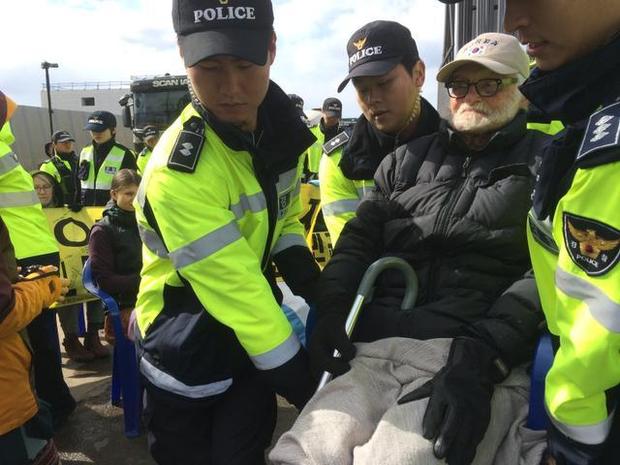
The Rev. Bill Bichsel, center, is moved from his protest site by police during the Tacoma priest’s trip to South Korea earlier this month. COURTESY OF EUNMI PANG The Rev. Bill Bichsel, an 86-year-old Tacoma priest known for his acts of civil disobedience, has returned from a trip to South Korea to protest construction of a naval base there.
Just three months ago, Bichsel was seriously ill and in the hospital in Tacoma. But his health — while still frail due to a heart condition — improved to the point he was able to make the trip using a wheelchair.
He said his doctors didn’t try to stop him from traveling.
“They just shake their heads,” Bichsel said. “They know I’m going so they don’t make a big fuss.”
For nearly 40 years, the Jesuit priest known as “Bix” has protested against U.S. military programs and weapons. He’s been arrested dozens of times for trespassing during protests and jailed more than a half-dozen times.
He wasn’t arrested in South Korea, but he realized the 12-day trip could set his health back.
“I know I could go anytime,” Bichsel said.
He was weak upon returning Nov. 20, but has gotten stronger since. And he was inspired by the trip.
Bichsel and nine other people — nearly all from the Puget Sound area — traveled to Jeju Island to commit what he called “acts of civil resistance” against construction of a base by the South Korean Navy. The base has been under construction on the island off the southern tip of Korea for eight years.
The efforts to stop it has been underway at Gangjeong Village since construction started, Bichsel said. The movement has united Catholics, Buddhists and those of no religious affiliation.
“It’s the most inspiring, unified resistance that I’ve experienced,” he said.
Bichsel said residents of the area believe the base will be used to service U.S. Navy ships. Some of those vessels could be armed with missiles as part of a defense system, he said.
The base is a few hundred miles from China.
The group joined other protesters — including Korean Catholic nuns and local villagers — to block cement trucks from entering the base.
They sat in chairs in front of the gate. Bichsel sat in a wheelchair. While they blocked the entrance, a priest celebrated the Mass across the street about 50 yards away as part of the resistance.
The protesters didn’t move until Korean police carried them away so the cement trucks could enter.
Three police officers picked Bichsel up in his wheelchair four or five times a day and pulled him to the side, he said.
He and the others would then go back and resume sitting in front of the gate.
“It’s sort of like a choreography,” said Bichsel, who uses a wheelchair because he can’t walk long distances.
The protesters, who numbered on average about 20, slowed the trucks but didn’t stop them from entering the base. No one was arrested, Bichsel said.
He also protested at the Jeju Island base during another trip in September 2013.
The priest said he’s demonstrating against the “continual militarization of South Korea, as well as our world, through the U.S. military.”
Local residents “know eventually the base will be built, but that doesn’t stop the villagers from standing up against it,” he said.
Bichsel, whose trip was financed by donations, said he was inspired by the commitment of Koreans who oppose the base.
“We get from them just a tremendous sense of faithfulness, living out what you believe, trying to stop the militarization.”
Bichsel has no immediate plans to return to South Korea. He’s planning his next act of civil disobedience much closer to home Jan. 17.
That’s when he plans to take part in an annual protest against nuclear weapons at the Navy’s Bangor submarine base on Hood Canal.
Steve Maynard: 253-597-8647 steve.maynard@thenewstribune.com @TNTstevemaynard
-
Jeju Solidarity Forever
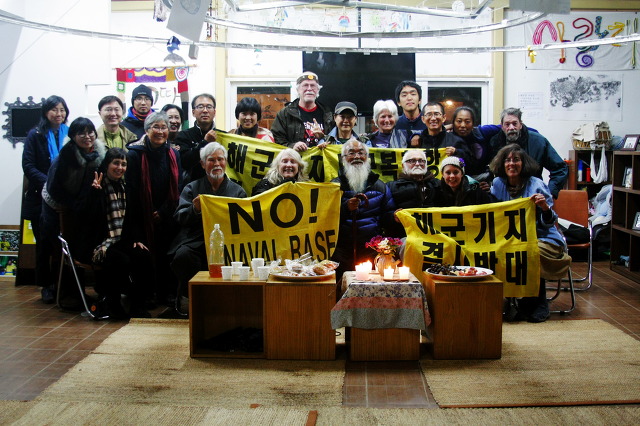
A photo by Emily Wang Re-blogged from here .
To see more on the visit by nine delegations including Fr. Bix from the United States, see the Puget Sound Nuclear Weapon Free Zone (Nov. 2014)
By Bruce Gagnon, November 19, 2014
The nine person Washington state peace delegation to Jeju Island, South Korea is nearing the end of their solidarity visit. Last night they held a meeting with villagers and supporters for extended sharing. Here is a brief report from Emily Wang:
Yesterday night, we had a really inspiring sharing and dialogue with 9 foreigner visitors including Father Bix. With this chance, they shared their experiences and people here also expressed our thankfulness. We encourage each other in this long struggle and have question to each other. For instance, how to deal with anger, trauma…? What we gonna do if the [Navy] base construction is finally completed etc…?
This is a wonderful community time.
See more photos hereMira Leslie, one of the delegation who lives in Seattle, writes from Jeju Island:
In less than 24 hours we will depart Gangjeong village. Jean left this morning. The goodbyes started yesterday. There is tremendous gratitude to us for coming here. In some ways I don’t understand that – hosting and feeding ten people for 10 days is a tremendous task. We have had ‘special meal’ almost everyday – and the regular food at the communal kitchen is delicious – but not too varied. Kimchee varieties, rice and soup- yum. We have been taken to tourist spots including the amazing Buddhist temple grounds and there have been several meetings with key leaders of the movement – each imparting intense information.
The community of resistance receives support from visitors – it helps them to have people doing 100 bows and blocking the gate during mass-Eucharistic resistance. The sister nuns are a steady presence – rotating through here from diocese throughout Korea. Foreign visitors are embraced warmly. The community is tired, but still very together (from an outsider perspective). For me, this time will be impossible to forget – and I am sure I’ll ruminate on it after leaving.
How can we to bring this back to our communities – and honor all we have learned?
The town is decorated with natural images – of peace. Peace Zone, dream catchers, sea creatures, Gureombi rock. We learned yesterday at the stone museum and grounds “the very deep meaning of stone here’ – much of it volcanic. It is building material, fencing, tools, food prep, sinks, toys and games, water vessel, art, music….
Last night we sat at the peace center with the activists, priests, and a few towns people. Father Bix and I described some of our peace work in the US and then they asked questions to all of us. They had 2-3 sentence bios of each of us that had been translated and printed. At one moment an activist said – everyone sees the damage done to the environment here – but no one can see the deep anger and damage in our hearts. She asked Sonya who works with trauma teams internationally for advice. You could see the reactions – it wasn’t expected – Korean people don’t talk too much about their feelings.
The village produces lillies for Japan, a sister told me as we walked to the gate today – but many of the lilly greenhouses were destroyed when they started the base. There is still fishing – but it is diminishing as the sea is being altered with destruction of the fragile soft coral reefs, damage from concrete, blasting, construction toxins/waste and later with ship pollution – oil, fuel, human waste.
We were gifted t-shirts today by the international team. The image is of Jeju island with an open mouthed shark on one end – the shark is in US stars and stripes with the Korean script word ‘Imperialism’.
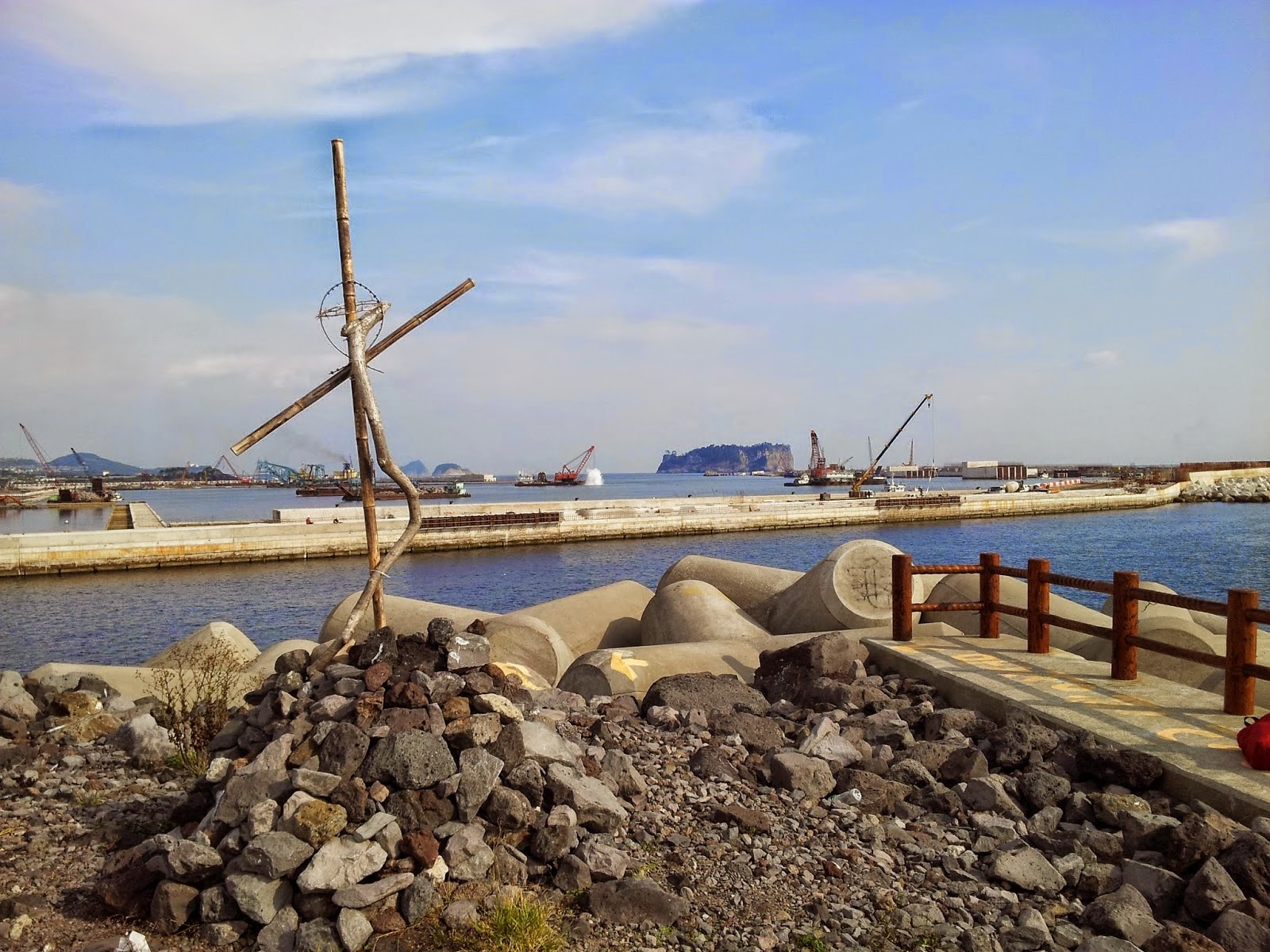
A photo by Mira Leslie
-
Living the Eucharist: resisting the destruction of Jeju Island
Re-blogged from here.

Police surround Art Laffin and other activists as they protest at the main entrance of a U.S.-backed Korean naval base on Jeju Island. 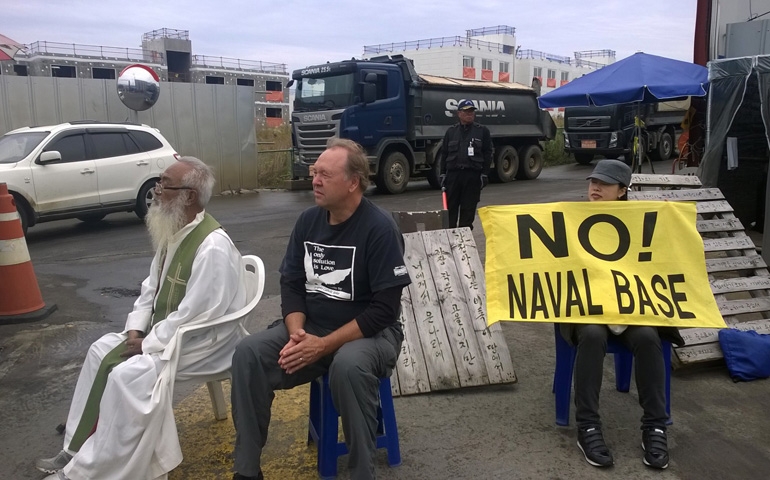
Fr. Mun Jeong Hyeon, Art Laffin, and another protester during the Mass at the main entrance to the construction site of a U.S.-backed Korean naval base on Jeju Island 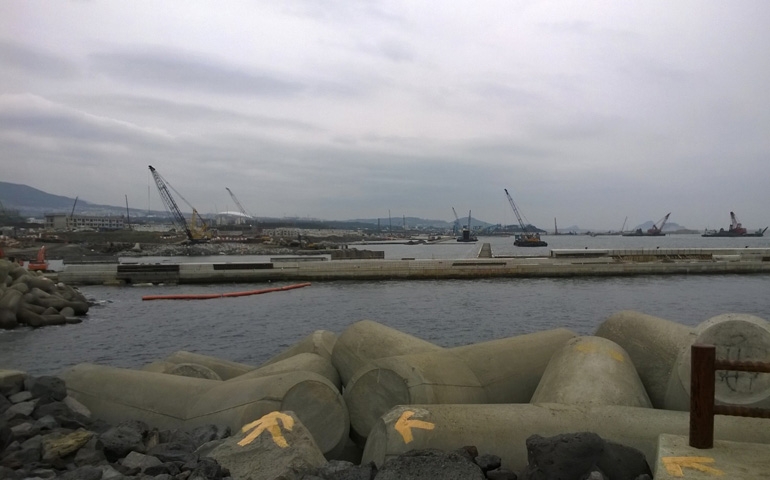
Construction continues on a U.S.-backed Korean naval base on Jeju Island. | Nov. 12, 2014
REFLECTION
I had the opportunity to travel to Jeju Island off the coast of South Korea in the East China Sea from Oct. 29 to Nov. 4. I previously spent four days in Manila, Philippines, where I was invited to speak at the first Asia Pacific Dialogue on Human Rights and Respect for the Dignity of Life with the theme: “No Justice Without Life.” I left an amazing community in Manila standing for life and justice and saying “No” to state-sponsored killing. In coming to Jeju Island, I met another extraordinary gathering of people who are saying “Yes” to creation and “No” to the construction of new naval base that is a crime and a sin.
For several years, I have been closely following this inspiring nonviolent campaign led by local islanders along with priests and sisters to stop the construction of this U.S.-backed Korean naval base on Jeju Island (named the “Island of Peace” by the Korean government).
UNESCO considers Jeju Island and nearby Beom Island, Moon Island, Seop Island, and Hallasan National Park biosphere reserves. The construction of this base, which is a joint Korean, U.S. and Japanese venture with Samsung as the main contractor, is destroying the beautiful ecosystem of the island as well as the majestic soft coral reefs and surrounding ocean life.
The ancient Gureombi rock formation no longer exists, having been blasted away two years ago. Inthe March 2014 issue of the Gangjeong Village Story monthly newsletter, the lead article lamented the second anniversary of the destruction of this sacred formation: “For thousands of years, Gureombi has been a playground, a garden, and a mother’s arms, embracing and embraced by the people of Gangjeong. Thus it was perhaps the most painful and sorrowful moment of this 8 year struggle to experience the partial destruction of Gureombi Rock. Still, though we cannot see Gureombi anymore, it lives on in our memories.”
Ultimately, the U.S. wants to use the base as an outpost to contain China. Peacemakers from the United States, including Bruce Gagnon, Regis Tremblay, David Hartsough, Ann Wright, Jesuit Fr. Bill Bichsel, Nick Mele, Kathy Kelly, Brian Terrell and Michele Naar-Obed, have come here to offer support over the last several years, and the local campaign has been deeply appreciative for this friendship and solidarity.
Upon arriving in Jeju City, I received a very warm welcome by Fr. Pat Cunningham and the Columban religious community, who offered me hospitality for the night. The next morning, Father Pat and I took as bus to Gangjong Village, about an hour from Jeju City. We arrived just in time for the daily 11 a.m. Mass that occurs directly outside the entrance to the base construction site.
Father Pat and I joined with other friends, including longtime renowned peacemaker Fr. Mun Jeong Hyeon, who has spent nearly three years in prison for his resistance, in sitting on plastic chairs stretched out across the base entrance. As grace would have it, I also became reacquainted with two of the local organizers whom I had previously met in D.C.: Sung-Hee Choi and Jung Joo.
There were at least eight people from the community sitting in chairs, blocking the center of the entrance. As streams of cement and supply trucks entered and exited the base, police carried those blocking to the side of the entrance. Then the police permitted those forming the blockade to return to the entrance, where they continued the witness. This back-and-forth went on for at least one and a half hours.
Celebrating Mass and receiving the Eucharist in this context was a very powerful experience. In the face of this monstrous base, which is now halfway complete, the power of eucharistic love, borne out in nonviolent witness, is the means by which true conversion and transformation can occur. Those gathered at the base entrance, along with at least 30 people who also attended the Mass a short distance away, truly believe in miracles and that with God all things are possible.
Following the Mass, the gathered community prayed the rosary. This was followed by a press conference by the Gangjong Village Association, calling for an end to the expansion of military housing units being built in the village as a result of the new naval base. I then was invited on a tour of the port area of the island, where one can see a panoramic view of the massive base construction.
Cranes are visible everywhere on the site, while in the port, there is constant dredging to accommodate future warships. The Korean government has described the new base as a joint military port complex meant to encourage tourism in the beautiful landscape. Despite this and other attempts to deceive the public about the real purpose for the base, local villagers and their supporters refuse to be duped.
In the late afternoon, I met Yang Yoon-Mo, a well-known former film critic who has endured long-term imprisonment and hunger strikes for trying to stop the construction of the naval base. He is one of the more than 650 people who have been arrested for saying “No” to the naval base construction. There have also been 550 indictments for resisters, and about 45 people have served jail sentences for their courageous resistance. Yang and several others have set up a new vigil site at another part of the base perimeter where supply trucks are being redirected from the main entrance. Many villagers are upset that these trucks are now diverted through their neighborhood.
On Nov. 1, All Saints Day, I joined two other friends, Jesuit Fr. Kim Song Hwan and Gayun, in blocking the cement and supplies trucks. Moments after receiving the Eucharist, four police from the base hoisted me in my chair, banner in hand, and carried me over to the side of the road as they had done with Father Kim and Gayun. It was indeed a moving experience in more than one way! Once the traffic cleared, the three of us resumed our positions blocking the main entrance. This would happen two more times, once during the rosary and once when the human chain was formed across the road.
The Eucharist and the rosary have taken on a whole new meaning for me here as they occur in the context of an act of nonviolent resistance. In the face of this new port of death being constructed, I feel a power here that is far greater, that can truly overcome the idolatrous forces of military violence: the self-emptying, transforming love embodied in a living Eucharist.
The resiliency of this community is quite remarkable, and they remain deeply committed to a spirited resistance despite overwhelming odds. After the rosary ended, a human chain of about 30 people stretched across the entire entrance to the construction site. As I was still being surrounded by police who had carried me to the side of the entrance, I was handed the mic to lead several songs. I started off with “When the Saints Go Marching In,” which was followed by “Down By the Riverside” and “Seek Peace and Pursue It,” singing with police literally hovering over me as I sat in my chair. Following the human chain, there was an enthusiastic snake dance, then some exuberant dancing. The police, for the most part, let all this go on but continued to move anyone impeding supply vehicles from going into the site.
On my last day in Gangjeong Village, I joined the blockade at main entrance to the construction site and was carried off four times. After the rosary, I was carried off as I sang “We Shall Not Be Moved.” I later asked Father Kim about the history of having the Mass at the base construction site. He told me that in 2009, Bishop Peter Kang U-il of Jeju Island, chairman of the Catholic Bishops’ Conference of Korea, first celebrated Mass on the land designated to be the base. In 2011, Father Mun initiated having the Mass outside the main entrance of the construction site for the base. Father Kim also shared with me that he is assigned to be part of this nonviolent witness to stop the base construction and has been joined by other Jesuits, including his provincial, in blocking the base entrance.
My friend Bruce Gagnon, longtime peacemaker and coordinator of the Global Network Against Weapons and Nuclear Power in Space, was the first one to introduce me, as well as countless others, to the nonviolent struggle in Jeju Island to stop construction of a new U.S.-backed naval base. His inspiring peace work has not only included stopping construction of this new base, but campaigning to stop the militarization of space and for the closing of the nearly 1,000 U.S. military bases worldwide. When addressing the struggle on Jeju Island, Bruce makes an important point that bears repeating: This nonviolent campaign to stop the construction of the new naval base on Jeju Island is an important symbol for the international peace movement. It brings together all the issues — militarization, disarmament, the environment and human rights. I couldn’t agree more with him.
Hopefully, before it’s too late, more people will join and support the courageous people of Gangjeong Village in the struggle to stop the building of this base meant for death and destruction. I encourage people to see Regis Tremblay’s excellent documentary, “The Ghosts of Jeju,” which is the most important resource available about the nonviolent struggle on Jeju Island. For updates about the campaign and ways you can support it, go to savejejunow.org.
[Art Laffin is a member of the Dorothy Day Catholic Worker in Washington, D.C.]
-
2014 Gangjeong Grand March for Life and Peace International Solidarity Messages
Collection of links: messages with Korean translations (see here)
As in 2012, 2013, many international peace activist friends have thankfully sent us solidarity messages. (click for 2012 messages and 2013 messages) The below is the collection of each message. The Columban JPIC has been willing to initiate a petition for solidarity with Gangjeong (click here). Bruce Gagnon, coordinator of the Global Network against Weapons and Nuclear Power in Space (space4peace.org) and Angie Zelter (tridentploughshares.org), 2012 Nobel Peace Award nominee, have sent us video messages and they were screened in our Aug. 2 cultural event, the end of our march program. Some early messages were put in our march literature that was distributed to the march participants today. Some messages were put in excerpts in our July-August newsletter (click here, page 5) and will be put in our Peace Center to remind people here of your friendship and solidarity.
Thanks so much Eun-young Lydia Park to translate many messages. Thanks so much, all the international friends who sent us messages, again.
Angie Zelter(UK) and Bruce Gagnon (US)
Sherrin (Australia)
Keep fighting the good fight. Though i can’t march by your side my thoughts and prayers are with you every step. Much love Sherrin
–> See the Korean translation, here.
Bayan (New Patriotic Alliance – Philippines) and Ban the Bases (Philippines)
Dear Friends in Gangjeong Warm greetings from Bayan ( New Patriotic Alliance – Philippines) and Ban the Bases! Attached are photos of our solidarity action for the Gangjeon 2014 March for Peace and Life. We carried paper placards that made the following calls: Save Jeju Island! Ban the [ROK]US Naval Base Now! Resist US Militarism and War!Ban the US Bases Now! Stop [ROK]US Naval Base in Jeju! We wish success to the Gangjeon March for Peace and Life on July 29 – August 02.Long Live International Solidarity! Yours Sincerely, Rita Baua, International Solidarity Officer Boyette Jurcales, Coordinator, Ban the Bases
–> See the Korean translation and more images, here.
HOBAK & friends/diasporic Koreans in the Bay area (United States)
stay strong, gangjeong! we stand in solidarity with you, and others around the world struggling for self-determination! 투쟁! sending love, hobak & friends/diasporic koreans in the bay area
–> See the Korean translation, here.
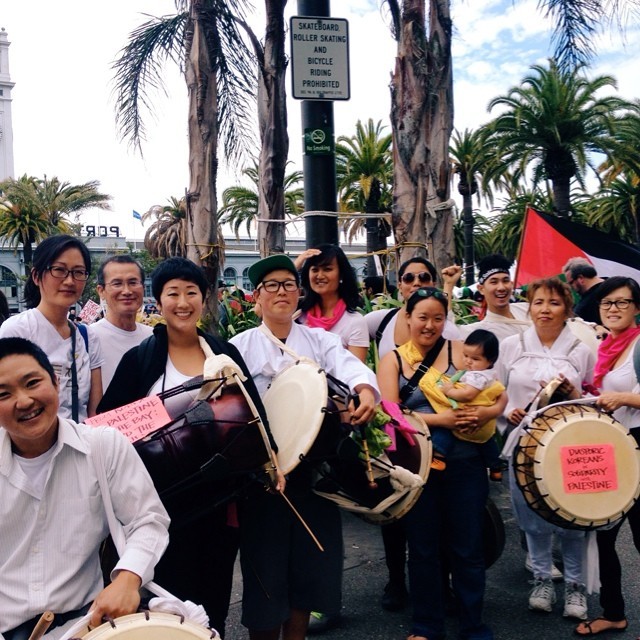
KEEP (Korea Education & Exposure Program)-ROK 2014 (United States)
We, the KEEP-ROK 2014 delegation, stand in solidarity with the people of Gangjeong in the struggle for peace and justice. 해군기지결사반대! 생명평화강정마을! As Koreans in diaspora living in the US, we absolutely object and denounce the naval base construction, the extreme militarization of the Asia Pacific, and the immense violence perpetrated by US imperialism. Your strength and fierce resistance is deeply inspiring, and our spirits are with you on the Peace March! Love & Solidarity, KEEP-ROK 2014.
–> See the Korean translation and more images, here.
Jack and Felice Cohen-Joppa (The Nuclear Resister, United States )
To our friends who so steadfastly oppose the construction of a naval base on the Island of Peace: With every step of your peace walk, our thoughts are with you. Every day when you sit in the road at the entrance gate, our thoughts are with you. During each act of conscience and resistance, many of us – near and far – stand in solidarity with you. Every day we remember and are thankful for the activists who are in a prison cell. Your persistence and faithfulness is an inspiration to so many around the world. Our struggle for a peaceful and disarmed world is one struggle! Jack and Felice Cohen-Joppa, The Nuclear Resister, Tucson, Arizona, U.S.
–> See the Korean translation, here.
Paul Schneiss (Germany)
Dear friends, i am traveling… [..] Today sleeping all day. Bu never forget Gangjeong. Wherever I go I talk about Gangjeong. My experience of Gangjeong. And your experience as I know. And the Gangjeong peoples life and hopes and decidedness and courage… Peace does not come by itself, we have to fight for it (fight and peace?!). So please send me pictures and stories from the march. I will put those on our Homepage.[..] Peace be with you, Paul Paul Schneiss, Heideberg, Germany
–> See the Korean translation, here.
Christine Ahn (United States)
My dear villagers Greetings from Washington, D.C. Where I am just leaving a historic march and rally at the White House on the occasion of the 61st anniversary of the Korean War armistice. Hundreds of Koreans from the us and South Korea along with their American allies marched to urge president Obama to end the Korean War and to sign a peace treaty. At the rally in front of the White House I challenged Obama’s notion that the Korean War was a victory. How are 10 million families separated victory? How is the militarization of korea a victory? How is the repression of democracy on both sides of the Dmz a victory? There were over 50 youth there and I told them seeing their faces gave me great hope, that we need them to carry the torch for peace so that like me who learned from my elders they can help educate my two year old jeju whom I named after the fierce resistance against the naval base. From Washington, D.C. To honolulu hawaii coast to coast across the United States the people are moved and inspired by your courage and belief in a different future, a peaceful future that isn’t militarized. Thank you for risking your whole lives for peace. May justice rain down on you soon. With love Christine Ahn, Executive Director of the Korea Policy Institute, co-founder of the National Campaign to End the Korean War
–> See the Korean translation, here.
Koohan Paik ( Hawai’i)
There are so many heroes in Gangjeong, that it is difficult to count them all. By “hero,” I mean a person with great courage and strength who makes unlimited sacrifices for the good of all humanity. One such hero is Father Mun Kyu-hyun. During last year’s march, he was asked by the film director Oliver Stone why he crossed the DMZ to North Korea, even though he knew that it would result in long-term imprisonment. Father Mun grinned bashfully and tilted his head. Then he explained, “That is the road to peace.”
The Grand March for Peace and Life is another road to peace. Every summer, people come from all over Korea and even the world, to join the Jeju Islanders in this weeklong march. The parade of yellow-shirted men and women, boys and girls, never fails to inspire all onlookers. They are inspired because they are seeing something rare in our world — a vision of real democracy. Korea is so lucky to have Jeju Island, and all the brave, strong, beautiful heroes who will never stop fighting to save her. Thank you, Gangjeong, for inspiring me, too. Koohan Paik, Hawai’i
–> See the Korean translation, here.
Sato, M. (Japan)
Seeing the current insanity towards ordinary people in Gaza and Uklaine, struggles in Gnagjeong remind us of the conscience and the sensibility of human beings. As we citizens here are powerless, Japan is being arbitrarily and fundamentally changed, from defensive to offensive. One predictable consequence to that might emerge on the Korean Peninsula. The tragic horrible history must not be repeated. In our hearts, we would walk for peace and young lives. We would stand by those courageous local citizens in Gangjeong.
–> See the Korean translation, here.
The Sea of Okinawa
Mariko (Japan)
Matsuno, Kiyoko (Japan)
I wish I could join the Walk, but it might be too hot for me.
In the near future I would like to visit Gangjeong again.
We, me and my friends in Osaka, always remember you and
think of you.
Your work for peace encourages us to keep fighting against
militarism in Japan.
Only peace can make the world peaceful, not weapons.
Thank you for all the work you, Gangjeong people, do for peace.
Best wishes,
Kiyoko Matsuno, Japan
–> See the Korean translation and more images, here.
Lindis Percy ( UK)
MESSAGE OF SOLIDARITY TO THE GRAND MARCH FOR LIFE AND PEACE 2014
Sent by Lindis Percy – Coordinator on behalf of the CAMPAIGN FOR THE ACCOUNTABILITY OF AMERICAN BASES (CAAB) www.caab.org.uk also on Facebook and Twitter
We send you greetings, solidarity and love as you march for life and peace. We will be with you in spirit – every step of the way!
We are so inspired and impressed by your persistence and resistance – peaceful and steadfast. You shine a light in a very dark and troubled world. Along the way many people will have had their minds and hearts opened by you as to what the US military are doing on the beautiful island of Jeju.
Your flag flies at the Tuesday weekly demonstration when we gather at the American base – NSA/NRO Menwith Hill. PEACE friends.
With much love
Lindis
–> See the Korean translation and more images, here.
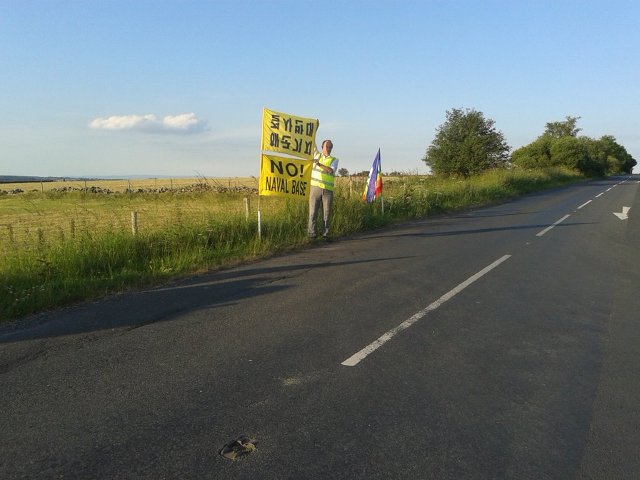
‘Your flag is with us every Tuesday pm opposite the main entrance to NSA/NRO Menwith Hill – crucially connected to the US Missile Defense System.’ 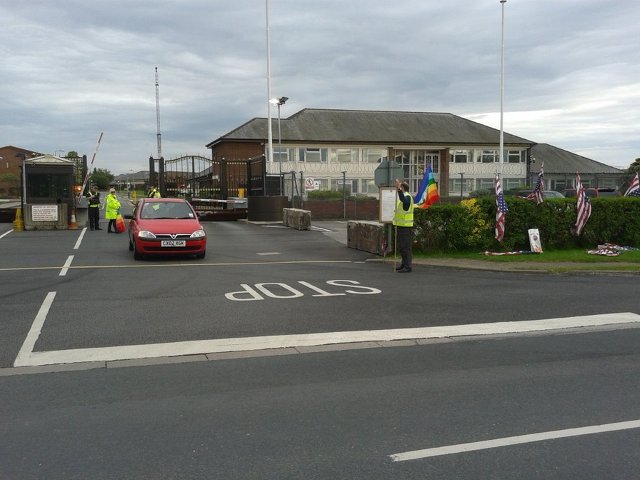
‘We have been at the gates of NSA/NRO Menwith Hill every Tuesday pm (except 4!) for 14 years. The number of people who come varies very much. This night there were just 3 of us….but we were there! It is very hard in the UK to get more. We are concerned with the presence of the US Visiting Forces and their Agencies here and world wide. That is why we are in solidarity with you in your struggle.’ Kelly, Kathy (United States)
Dear Friends,
From here in Kabul, we’re grateful to catch courage from you. Wars and threats of increasing violence afflict Afghanistan, and so we are all the more grateful for your insistence that we can nonviolently resist the war makers. Thank you for your vibrant, creative and tenacious witness. Your commitment to peaceful seas inspires us here in landlocked Afghanistan as we share in your dreams and your efforts to be guided by your visions of a better world.
Sincerely,
Kathy Kelly
co-coordinator of Voices for Creative Nonviolence
–> See the Korean translation and more images, here.
Hakim with the Afghan Peace Volunteers (Afghanistan)
“No Naval Base!”
Your yellow banner of protest adorns the wall of our library in the Borderfree Community Centre of Non-violence in Kabul, Afghanistan.
The Afghan Peace Volunteers seek to emulate your beautiful community’s resilience in resisting the global military industrial complex.
With you, we wish to sing against the militarization of Mother Nature and our common spaces, and dance with you for a world without war.
When you walk, know that you’re strengthening us across all borders.
Thanks for showing us that even if we were the defenseless underwater soft coral not seen by the world, we can remain soft, we can insist on being colorful, and we can link hands to enrich a part of the vast, untamable sea.
With love and peace from Afghanistan,
Hakim with the Afghan Peace Volunteers
–> See the Korean translation and more images, here.

Australian Anti-Bases Campaign Coalition Pax Christi Australia, and MSC Justice & Peace Centre (Australian Province)
To all those taking part in the 2014 Gangjeong Grand March for Life and Peace, we send a message of solidarity and hope.
Unable to be with you in body, we stand with you in heart and mind, and thank you for the opportunity to do so.
We condemn the cultural and environmental damage that Gangjeong is suffering at the hands of the ROK and US navies, and the injustices being imposed on its people, especially activists.
Your bravery, creativity and determination not to be silenced are sources for strength and inspiration for peace activists throughout the world.
We share your goal of preserving Jeju’s status as the world’s Island of Peace.
We share your goal of bringing to an end the construction of the naval base within you precious waters.
We share your dream of a region whose constituent nations pursue peace together through disarmament, mutual respect, cooperation and dedication to non-violence and justice.
We share your passion for peace.
AUSTRALIAN ANTI-BASES CAMPAIGN COALITION
PAX CHRISTI AUSTRALIA (Fr. Claude Mostowik)
MISSIONARIES of the SACRED HEART JUSTICE & PEACE CENTRE (AUSTRALIAN PROVINCE)
–> See the Korean translation, here.
The Liem Family (United States)
Gangjeong villagers and internationalists: your eight years of struggle and sacrifice against the interests of the South Korean and U.S. military/industrial complex are an inspiration to peace and earth-loving people everywhere.Your unbreakable will and spirit, not Korea’s corporate prestige, technological achievements or K-Pop, are the nation’s true gifts to the world.
In solidarity for people’s justice on the Island of Peace,
The Liem Family (Joan, Ramsay, Deann and Paul)
–> See the Korean translation, here.
Kyle Kajihiro, Hawaiʻi Peace and Justice and the DMZ-Hawaiʻi / Aloha ʻĀina network
Aloha dear friends in Jeju!
From Hawaiʻi Peace and Justice and the DMZ-Hawaiʻi / Aloha ʻĀina network, warm greetings and solidarity!
Congratulations on the commencement of your 2014 Grand March for Life and Peace! Thank you for your tireless efforts. As you begin your march, the U.S. military and the militaries of twenty-two other countries continue their RIMPAC military exercises in our islands, an example of the unbearable costs and consequences of endless war.
Do not believe the lie that mili-tourism has been good for Hawaiʻi. While some people reap the benefits of the military-industrial complex, most local residents and the environment pay a very high price: environmental destruction, displacement from the land, rising costs of living, sexual violence, and accidents. You walk for all the people of the world who dream and struggle for peace and justice. Peace for Jeju! Peace for the world!
In solidarity
Kyle Kajihiro
–> See the Korean translation, here.
Columbans and friends in Chile
Columbans and friends in Chile support the campaign against the building of the naval base in Gangjeong,Jeju! They are in solidarity with you this week as you walk for the life and peace of the beautiful island of Jeju! This is the message I was asked to convey to you below! The link below to the protest letter handed in at the Embassy in Santiago is in Spanish! ‘This morning, a group of representatives of the columban family in Chile (Lay missionaries, co-workers, friends of Saint Columban and Columban Youth) presented a letter in solidarity with the people of Jeju Island to the embassy of Korea asking the government to stop the construction of the naval base in Jeju, all this in the context of the celebration of “2014 Gangjeong Grand March for Life and Peace” you can see the report in Our website, here. or in our facebook, here. Cesar Correa Valenzuela Justice Peace & Integrity Of Creation Co-ordinator Society of St. Columban. Chile Familia columbana entrega carta a embajada de Corea por situacion en la isla de Jeju. #columbanos Puedes revisar la carta en
–> See the Korean translation and more images, here.
Yuichi Kamoshita(Japan) : An impression on joining march after it
Since I started to think about a Peace in my life, Korea, China, and Taiwan as well as Asian counties
where were invaded by Japanese imperial army and corporations are often in my mind. As our grand
or great-grand parents helped to invade these countries. I always have some pain in my deep heart.
The millions people of Korea lost their lives and livelihood.
Also, millions of Chinese, Germany, Russian, Japanese and more countries.
There are no borders that all civilians are victims and people still suffer from that war.
We still have difficult relationships between countries.
And this issue is always played on the political games which disturb a mutual understanding between
civilians.
In order to avoid this brain washing, we civilians need to avoid the mass-medias who are sponsored by the government and big corporations or powers.
The importance of international solidarity in grass roots level is now getting higher.
Communicating and sharing the experiences by visiting each other would be a very helpful to lift up
our awareness of understanding other life styles which a fact of all societies are depend on the natural environment and human culture from ancestors.
I joined the Grand March 2014 in Jeju. I had mainly 3 reasons to walk this island.
1, Of course, to express against naval base,but also offering a prayer for the victims of 4·3 and victims of Japanese colonization.
2, to feel Jeju, to understand the way of life. the great nature gives a life to the people of this island.
3, to meet and communicate with people of Korea and international friends.
And as I understood that this is a most front line of the peace action.
By visiting Gangjeong village and joining the movement, I was inspired by the leadership of religious
people, and a presence of international team. also a lot of young people take a part of this movement
which I couldn’t see in Okinawa’s movement.
It is my hope that more religious people stand up and dedicate their lives to the peace and social
activities.
Now Okinawa’s struggle is facing a turning point. a construction of expounding the Camp Schwab at
Henoko now started. at the same time Takae (Yanbaru forest)
Jungle warfare training center(U.S marine corp.) has been expounding the helipads by cutting down the forest life.
I consider that people of Okinawa need more international solidarity now.
Humbly,I ask people of Korea to come to stay in Okinawa for support and encourage the movement.
I also would start working for inter-island solidarity.
Kamsa Hamnida.
–>See the Korean Translation, here

Photo by Jeong Doryeong














